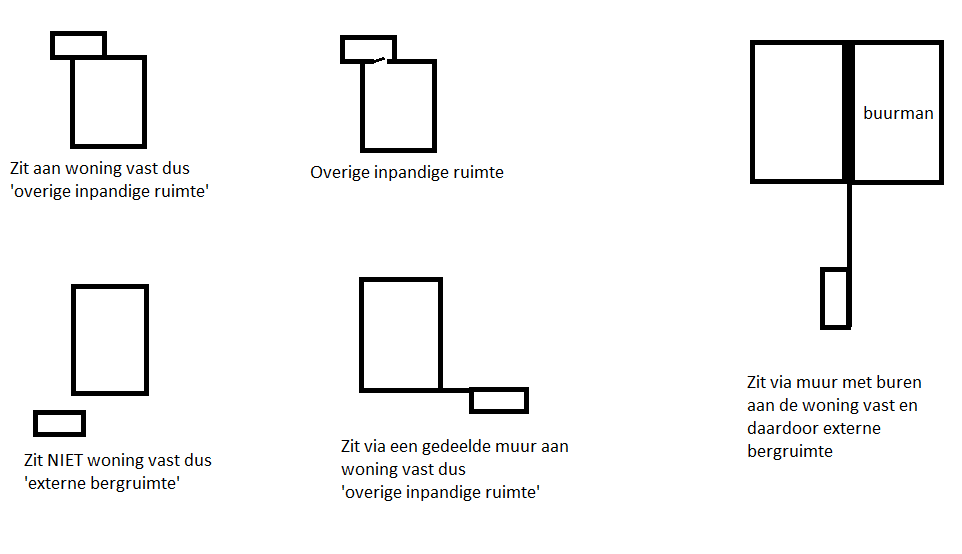When selling your home, the square footage of living space is perhaps the most important value determinant of your home’s market value and final selling price. But how should you calculate it?
In order to standardize all surface measurements of homes, the NEN2580 measurement instruction was created. If you are going to sell your home then there are a number of surface areas that we look at and these are:
- The usable area of your home (all the area where you can walk around)
- The part of this use area that we may call the living area (suitable to be used as living/sleeping space)
- The other indoor space (think cold and/or dark storage)
- Building-related outdoor space (your balcony or roof terrace)
- External storage space (think of the detached brick shed in your garden or your storage in basement of the apartment)
- The content of your home in cubic meters (m3)
- The size of your plot
For the value of your home, the most important factors are: the living area, your outdoor space and the area of your entire lot.
Step 1: Calculate the usable area
We’ll assume for a moment a standard house. Your home has 4 exterior walls that seal your home from the outside world. Start in the house by measuring the total area between those 4 walls. So from the inside wall between you and your left neighbor to the inside wall between you and your right neighbor. And then from the inside exterior wall at the front to the inside exterior wall at the back. Forget about all partitions, radiators, cable ducts, the staircase closet, pipes, skirting boards, support pillars (with less than 50cm diameter) et cetera. Also, forget about the space that is not directly attached to your home (your storage room in the garden or in the basement of your apartment). You don’t have to take all that into account. Just straightforward measurements from wall to wall. Do this for each floor in your home.
Attic
If you come to the attic, pay attention: all area that is lower than 1.50 meters should not be counted. Almost every attic has a sloping roof and so you will have a part that does not count. Everything higher than 1.50 meters in the attic may be included BUT there is one rule here and that is this; the attic MUST have at least 4m2 of area where it is at least 2 meters high. If your attic does not have this, then unfortunately anything under 2 meters in height may not count.
Vides
Also equally important are stairwells and any voids. For stairwells and voids, if they are greater than or equal to 4 m2, you may NOT count them in the user area. In most single-family homes, stairwells will not exceed 4 m2 so there is no need to consider this.
For example, the outcome of your recording is as follows:
| Deepening | Width | Length | Surface |
| Ground Floor | 5 | 10 | 50 m2 |
| 1st floor | 5 | 10 | 50 m2 |
| Attic | 4 | 8 | 40 m2 |
| Total: | 140 m2 |
So the total usable area of your home is 140m2.
Step 2: Calculate the remaining indoor space
The next step is to split the area of use. You’re going to split these into living area and other indoor space.
To determine the remaining interior space, go through the questions below. (Don’t worry, below we provide examples on these questions.)
- Is there space that is not structurally suitable or intended as living space. Think of a storage room, garage, bike storage? If yes: note the area of this room(s).
- Is the attic a storage attic? A storage attic is an attic if there is no fixed staircase and/or there is no window for daylight in it of at least 0.5 m2. If yes: note the area of this attic but forget any area lower than 1.5 meters (it does not count).
- Your attic has a fixed staircase and at least 0.5m2 of window area (daylight). Ok fine. So does your attic have at least 4 square meters of area where it is at least 2 meters high?
- Do you have a basement? Is it at least 2 feet tall and has no direct daylight? Then you do NOT have to count it under “other indoor space”. A basement may simply count as living space, as long as it is structurally intended to do so.
What this looks like in practice:
To question 1: For example, you have a storage room inside that was overwhelmingly built and intended as a storage room. This is where your bikes, gardening equipment, etc. are stored.
To question 2: For example, you have an attic that you can only reach with a Vlizotrap. Or you have an attic with a fixed staircase, but without a skylight of at least 0.5m2 in size. You then measure all the area of that attic that is 1.50 meters and above.
To question 3: You have an attic that is 2.20 meters high at its highest point. You are already going to calculate the area that is 2 meters and above. For example, the outcome is that you end up with exactly 3.5m2. Then you are unfortunately out of luck, because anything in the attic that is between 1.50 and 2 meters high, you may now not count as living space. This may only be counted as ‘other indoor space’.
Add up all these areas and you have calculated the total indoor space of your home.
For example:
| Storage space behind kitchen: | 8m2 | |
| Indoor garage: | 12m2 | |
| Part of the attic that is between 1.5 and 2m: (from an attic with less than 4m2 of space where it is at least 2 meters high) |
10m2 | |
| Total interior space: | 30m2 | |
Step 3 – calculate the living area
This is now very simple: take the usable area from step 1 and subtract the area of other indoor space from step 2. You have now calculated the living area of your home!
So in case of the given examples it is:
| Usable area of home: | 140m2 |
| Other indoor space: | 30m2 – |
| Living area: | 110m2 |
Calculating the building outdoor space
Note: we are not talking about the garden here! You may measure the garden separately and mention it where you wish. When we talk about building outdoor space we are talking about:
- Balconies
- Roof terraces
- Carports
- Veranda’s
- A first floor terrace adjacent to the house that rests on a support integrated into the building structure of the house
There is only building-related outdoor space to the extent that the portion is located next to, on, against, or attached to the dwelling.
Calculating this space needs no explanation. You measure exactly to where the space runs (neighbor’s wall, or e.g., eaves). The only exception is a covered outdoor space, you measure it up to the upstanding vertical partition of this canopy.
Calculating External Storage Space
Your external storage space is:
- Your storage room in the basement of your apartment building
- Your detached shed in the garden
- Your garage box opposite your home
Note that if the storage space is directly attached to your home, then it is an “other indoor space,” even if you cannot access it from the inside. This is true even if the storage room is a few feet away from your home, shares 1 wall with your home. That looks like this:

Calculating the contents of your home
To calculate the number of cubic feet of volume in your home, look back at your calculation from step 1 when you went to calculate the usable area of your home. Take the area per floor and multiply it by the height of the floor. If there are height differences in the ceilings, then you need to calculate the volume per room. Note that you must also include the partitions, dividers with the contents.
Oblique planes and round planes are a little trickier to calculate. It is going too far now to explain mathematical formulas for this that you can use to calculate this.
Calculating the plot of your property
We never calculate this. We always extract these from the cadastral extract. This extract can be ordered by anyone from his/her own property on the Land Registry website.

